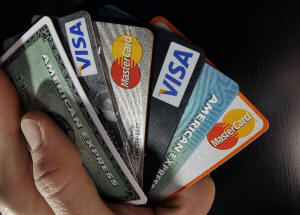What the Fed rate cut will mean for your finances
[September 18, 2025] By
CORA LEWIS
NEW YORK (AP) — The Federal Reserve cut its benchmark interest rate
Wednesday for the first time in nine months. Since the last cut,
progress on inflation has slowed while the labor market has cooled. That
means Americans are dealing with both high prices and a challenging job
market.
The federal funds rate, set by the Federal Reserve, is the rate at which
banks borrow and lend to one another. While the rates that consumers pay
to borrow money aren’t directly linked to this rate, shifts in Fed
policy affect what people pay for credit cards, auto loans, mortgages,
and other financial products.
Wednesday's quarter-point cut is the first since December and lowers the
Fed's short-term rate to about 4.1%, down from 4.3%. The Fed projected
it will cut rates two more times before the end of the year.
The Fed has two goals when it sets the rate: one, to manage prices for
goods and services, and two, to encourage full employment. This is known
as the “dual mandate.” Typically, the Fed might increase the rate to try
to bring down inflation and decrease it to encourage faster economic
growth and more hiring. The challenge now is that inflation is higher
than the Fed's 2% target but the job market is weak, putting the Fed in
a difficult position.
“The dual mandate is always a balancing act," said Elizabeth Renter,
senior economist at personal finance site NerdWallet.
Here's what to know:
A cut will impact mortgages gradually
For prospective homebuyers, the market has already priced in the rate
cut, which means it's “unlikely to make a noticeable difference for most
consumers at the time of the announcement,” according to Bankrate
financial analyst Stephen Kates.

“Much of the impact on mortgage rates has already occurred through
anticipation alone,” he said. "(Mortgage) rates have been falling since
January and dropped further as weaker-than-expected economic data
pointed to a cooling economy.”
Still, Kates said a declining interest rate environment will provide
some relief for borrowers over time.
“Whether it’s a homeowner with a 7% mortgage or a recent graduate hoping
to refinance student loans and credit card debt, lower rates can ease
the burden on many indebted households by opening opportunities to
refinance or consolidate,” he said.
Interest on savings accounts won't be as appealing
For savers, falling interest rates will slowly erode attractive yields
currently on offer with certificates of deposit (CDs) and high-yield
savings accounts.
Right now, the best rates on offer for each have been hovering at or
above 4% for CDs and at 4.6% for high-yield savings accounts, according
to DepositAccounts.com.

[to top of second column] |

In this March 5, 2012, file photo, consumer credit cards are posed
in North Andover, Mass. (AP Photo/Elise Amendola, File)
 Those are still better than the
trends of recent years, and a good option for consumers who want to
earn a return on money they may want to access in the near-term. A
high-yield savings account generally has a much higher annual
percentage yield than a traditional savings account. The national
average for traditional savings accounts is currently 0.38%.
There may be a few accounts with returns of about 4% through the end
of 2025, according to Ken Tumin, founder of DepositAccounts.com, but
the Fed cuts will filter down to these offerings, lowering the
average yields as they do.
Auto loans are not expected to decline soon
Americans have faced steeper auto loan rates over the last three
years after the Fed raised its benchmark interest rate starting in
early 2022. Those are not expected to decline any time soon. While a
cut will contribute to eventual relief, it might be slow in
arriving, analysts say.
“If the auto market starts to freeze up and people aren’t buying
cars, then we may see lending margins start to shrink, but auto loan
rates don’t move in lockstep with the Fed rate,” said Bankrate
analyst Stephen Kates.
Prices for new cars have leveled off recently, but remain at
historically high levels, not adjusting for inflation.
Generally speaking, an auto loan annual percentage rate can run from
about 4% to 30%. Bankrate’s most recent weekly survey found that
average auto loan interest rates are currently at 7.19% on a
60-month new car loan.
Credit card rate relief could be slow
Interest rates for credit cards are currently at an average of
20.13%, and the Fed's rate cut may be slow to be felt by anyone
carrying a large amount of credit card debt. That said, any
reduction is positive news.
“While the broader impact of a rate reduction on consumers’
financial health remains to be fully seen, it could offer some
relief from the persistent budgetary pressures driven by inflation,”
said Michele Raneri, vice president and head of U.S. research at
credit reporting agency TransUnion.
“These savings could contribute to a reduction in delinquency rates
across credit card and unsecured personal loan segments,” she said.
Still, the best thing for anyone carrying a large credit card
balance is to prioritize paying down high-interest-rate debt, and to
seek to transfer any amounts possible to lower APR cards or
negotiate directly with credit card companies for accommodation.
All contents © copyright 2025 Associated Press. All rights reserved |